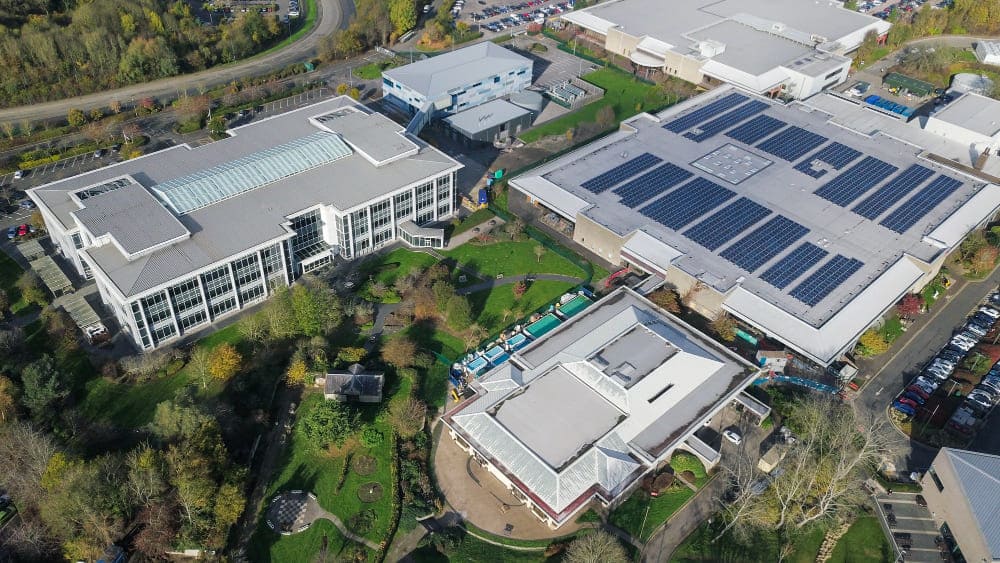

Commercial solar requirements include structural and electrical code compliance (NEC and IBC), solar permit design submission, energy efficiency verification, fire safety clearances (3 feet from roof ridges, 18 inches from hip/valley lines), inverter manufacturer installation standards, regular inspections, tax filing documentation, and utility interconnection coordination. The installation process spans 3-6 months across six phases: site evaluation, custom design, permit approval, financing selection, installation execution, and final inspection with utility interconnection.
Business leaders across the United States face mounting pressure to address climate change, navigate energy market instability, and meet stakeholder sustainability expectations. Commercial solar power delivers a proven path forward, offering measurable cost reductions and environmental benefits for organizations spanning industrial, agricultural, and commercial sectors.
Adopting solar energy extends beyond panel installation. Successfully navigating commercial solar requirements, including permitting protocols, design specifications, code compliance, and utility interconnection, requires strategic planning. Property owners who underestimate these critical components encounter project delays, regulatory setbacks, or inefficient systems that fail to deliver expected returns.
Federal incentives include the 30% Investment Tax Credit (ITC) and Modified Accelerated Cost Recovery System (MACRS), allowing five-year depreciation. A $1,000,000 commercial solar system generates $850,000 in depreciation deductions after ITC adjustments while reducing operating expenses by approximately $1,400 annually per average facility, according to Department of Energy data.
This comprehensive resource equips you with actionable knowledge for your solar project. Discover how to address building codes, execute proper solar permit design, and capitalize on federal tax incentives while ensuring full compliance and optimal system performance.

Every commercial solar project must satisfy specific technical, legal, and procedural standards before installation commences. While commercial solar requirements vary by jurisdiction, expect to address these fundamental elements:
Meeting these requirements positions your system for legal compliance, operational safety, lasting durability, and maximum solar incentive eligibility.
Understanding your installation timeline and procedural workflow helps you manage expectations and minimize business disruptions. A structured methodology ensures smooth progression through each phase, from initial planning to final inspection.
Start with a comprehensive evaluation of your commercial facility or installation site. Professional solar contractors examine:
This evaluation phase establishes your energy requirements and defines your system's power generation capacity and savings potential.
Once you've clarified project objectives and site constraints, your solar provider develops a tailored system design. Critical design elements include:
This design phase ensures your solar installation maximizes energy production while maintaining code compliance and integrating seamlessly with your facility infrastructure.
Secure necessary approvals by submitting a complete solar permit design package to your local building authority. Your submission package typically includes:
Your application must demonstrate energy standard compliance using either the prescriptive approach (fixed requirements) or the performance approach (custom modeling). Anticipate review periods ranging from several weeks to multiple months depending on local authority workload.
After completing the design and securing approvals, choose the financing structure that aligns with your business objectives. Available financing options include:
Your financing choice impacts long-term return on investment, operational expenses, and tax planning strategies. Understanding insurance and liability considerations also helps protect your investment.
With financing secured and permits approved, installation work begins. Your solar installation contractor manages the complete process, including:
Experienced solar installers adhere strictly to safety protocols, code requirements, and manufacturer specifications to ensure reliable system performance.
Before energizing your system, it must pass inspection by the Authority Having Jurisdiction (AHJ). Simultaneously, complete the utility interconnection procedure.
Final completion tasks include:
Upon completion, your system connects to the utility grid, delivering clean solar electricity to your facility and often generating excess energy for credit through renewable energy certificates (RECs).

While solar's environmental impact drives adoption, financial advantages provide equally compelling motivation. United States businesses access substantial tax incentives and rebates that improve return on investment.
Additional Financial Advantages
Combined, these financial benefits transform solar into a strategic asset for commercial property owners, rental properties, and qualifying residential projects under business ownership.
Beyond financial returns, solar power helps businesses decrease carbon emissions, reduce fossil fuel dependency, and advance sustainability objectives. Key environmental benefits include:
In today's marketplace, environmental leadership represents a competitive necessity rather than an optional consideration. Commercial customers investing in clean energy solutions demonstrate commitment to innovation, corporate responsibility, and sustainable growth. According to IEEE Power and Energy Society research, renewable energy adoption continues accelerating across commercial sectors.
Selecting the Right Solar Provider
Even exceptional solar planning delivers subpar results with poor execution. Choosing a qualified solar provider proves critical for project success.
Evaluate potential service providers based on these criteria:
Partnering with experienced solar professionals ensures your project moves forward efficiently from initial design through system activation and ongoing maintenance, helping your business reduce energy costs and achieve sustainability objectives. For those interested in expanding their knowledge, essential solar energy resources provide valuable insights into system design and implementation.
Transitioning to commercial solar power represents a significant strategic decision that delivers both immediate and long-term value for your business. While the process involves navigating complex requirements, from code compliance and permit submissions to utility interconnection and tax incentive optimization, the financial and environmental returns justify the investment.
Understanding commercial solar requirements positions your organization to avoid costly delays, ensure regulatory compliance, and maximize system performance. By addressing structural and electrical codes, securing proper permits, selecting appropriate financing options, and partnering with qualified solar professionals, you create a foundation for a successful solar installation that serves your business for decades.
The combination of federal tax credits, accelerated depreciation, reduced operating costs, and environmental benefits makes commercial solar one of the most effective investments available to businesses today. As energy costs continue rising and sustainability expectations intensify, organizations that adopt solar power gain competitive advantages through lower overhead, enhanced brand reputation, and demonstrated commitment to environmental stewardship.
Take action now to evaluate your facility's solar potential, engage qualified solar providers, and begin your journey toward energy independence and operational cost reduction. Your commercial solar system awaits, delivering clean, reliable, and cost-effective power for years to come.
How long does it take to complete a commercial solar installation from start to finish?
Commercial solar installation timelines typically range from three to six months, though complex projects may extend longer. The timeline breaks down into distinct phases: site evaluation and system design (2 to 4 weeks), permit application and approval (4 to 12 weeks depending on local authority workload), financing finalization (2 to 4 weeks), physical installation (2 to 6 weeks based on system size), and final inspection and utility interconnection (2 to 4 weeks). Factors affecting your timeline include local permitting authority efficiency, utility interconnection requirements, weather conditions, and system complexity. Working with experienced solar contractors who understand local requirements helps minimize delays and keeps your project on schedule. Utility-specific solar guides can further streamline the process.
What happens if my commercial building's roof cannot support the weight of solar panels?
If your roof structure lacks adequate load-bearing capacity for solar panel installation, you have several alternatives. Ground-mounted solar arrays provide an excellent solution when available land space exists, offering easier maintenance access and flexible panel orientation. Carport or parking structure solar installations serve dual purposes by generating power while providing covered parking for employees or customers. Roof reinforcement represents another option, though you must weigh structural upgrade costs against overall project economics. Your solar provider should conduct thorough structural engineering assessments during the site evaluation phase to identify load capacity limitations early and recommend the most cost-effective solution for your specific situation.
Can I install commercial solar panels without connecting to the utility grid?
Yes, off-grid commercial solar systems are technically feasible but require significant battery storage capacity to maintain power during nighttime hours and periods of low solar production. Off-grid installations prove most practical for remote facilities without existing utility access or businesses seeking complete energy independence. However, most commercial properties benefit more from grid-connected systems that use net metering, selling excess power back to the utility during peak production and drawing power when needed. Grid-connected systems cost less than off-grid alternatives since they require less battery storage, provide backup power from the utility during extended cloudy periods, and generate additional revenue through renewable energy certificates. Evaluate your specific operational needs, location, and budget to determine whether a grid-connected or off-grid configuration better serves your business objectives.
How do commercial solar requirements differ from residential solar installation requirements?
Commercial solar requirements typically involve more stringent standards than residential installations due to larger system sizes, higher voltages, and increased structural loads. Commercial projects require more detailed engineering documentation, including comprehensive load calculations, structural assessments certified by licensed engineers, and more extensive electrical diagrams showing three-phase power configurations. Commercial installations must comply with additional fire safety requirements, including wider equipment spacing and enhanced emergency responder access pathways. The permitting process for commercial systems takes longer and involves more review layers, often requiring approval from building departments, fire marshals, and utility engineering departments. According to the International Energy Agency's renewable energy report and REN21's global status report, commercial projects also qualify for different financial incentives, including accelerated depreciation and larger federal tax credits that residential systems cannot access. Despite these added complexities, commercial installations offer superior returns on investment due to higher energy consumption, better tax benefits, and economies of scale.
What maintenance does a commercial solar system require, and how much does it cost?
Commercial solar systems require minimal maintenance compared to other business equipment, but regular upkeep ensures optimal performance and longevity. Annual maintenance tasks include visual inspections of panels, racking, and wiring for damage or degradation; inverter performance verification; electrical connection testing; and panel cleaning to remove dirt, debris, or snow accumulation that reduces efficiency. Most commercial systems benefit from professional maintenance visits one to two times annually, costing approximately $200 to $500 per visit depending on system size. Panel cleaning frequency depends on your location; dusty or industrial areas require more frequent cleaning than regions with regular rainfall. Monitor your system's production data regularly to identify performance drops that may indicate maintenance needs. Many solar providers offer maintenance agreements bundling inspections, cleaning, and repairs for predictable annual costs. Budget approximately 0.5 to 1% of your total system cost annually for maintenance and repairs to keep your installation operating at peak efficiency throughout its 25 to 30 year lifespan. Understanding end-of-life solar panel management also helps with long-term planning.
We are dedicated to providing top-notch solar permit services to homeowners, business owners, DIY, and solar installers. Contact us today.